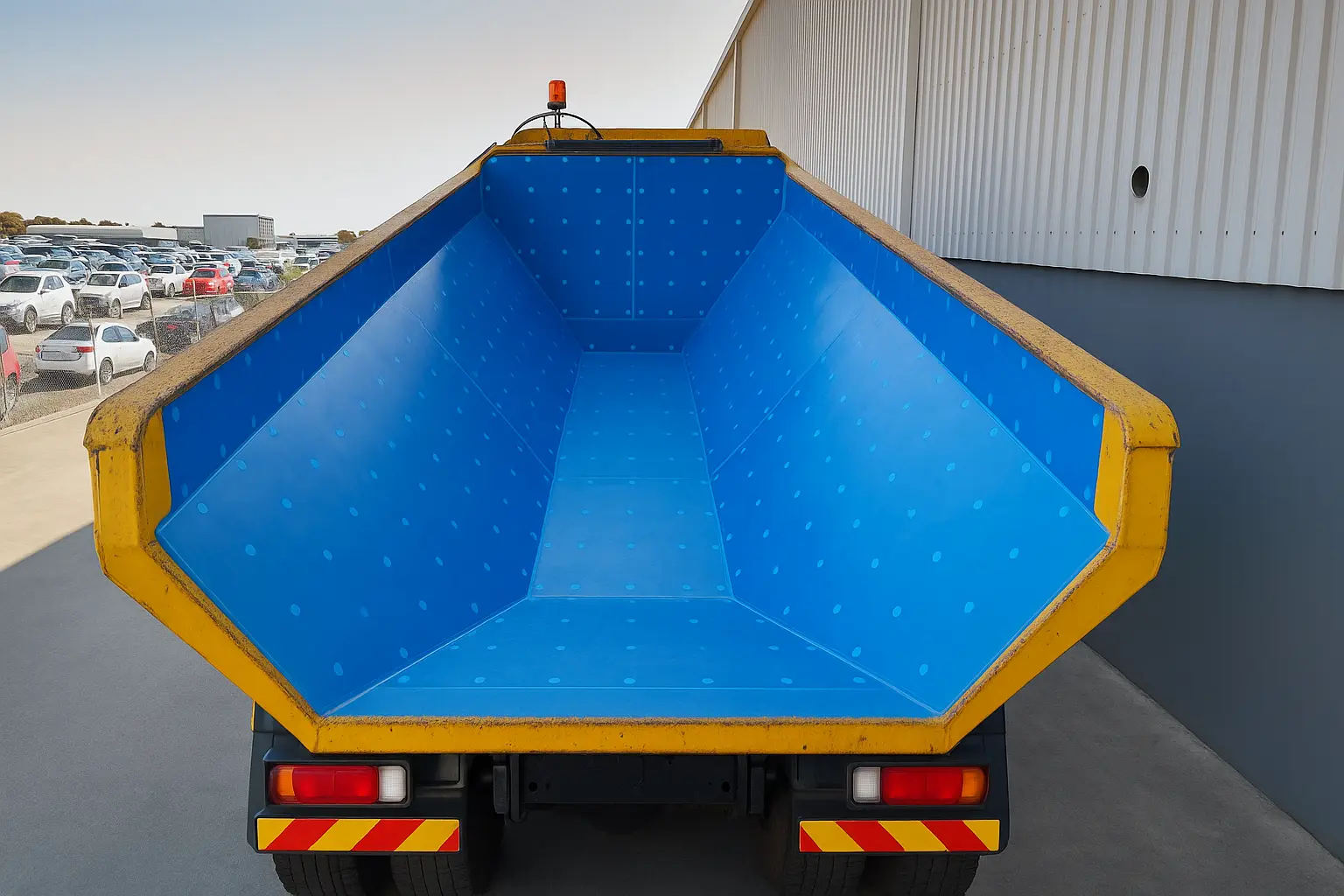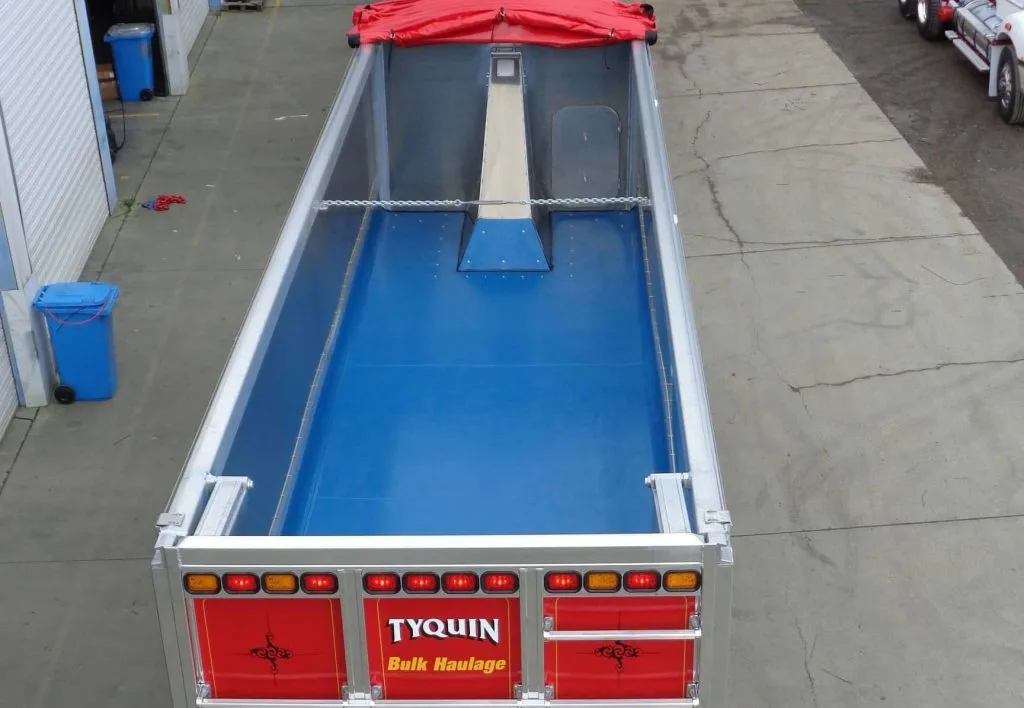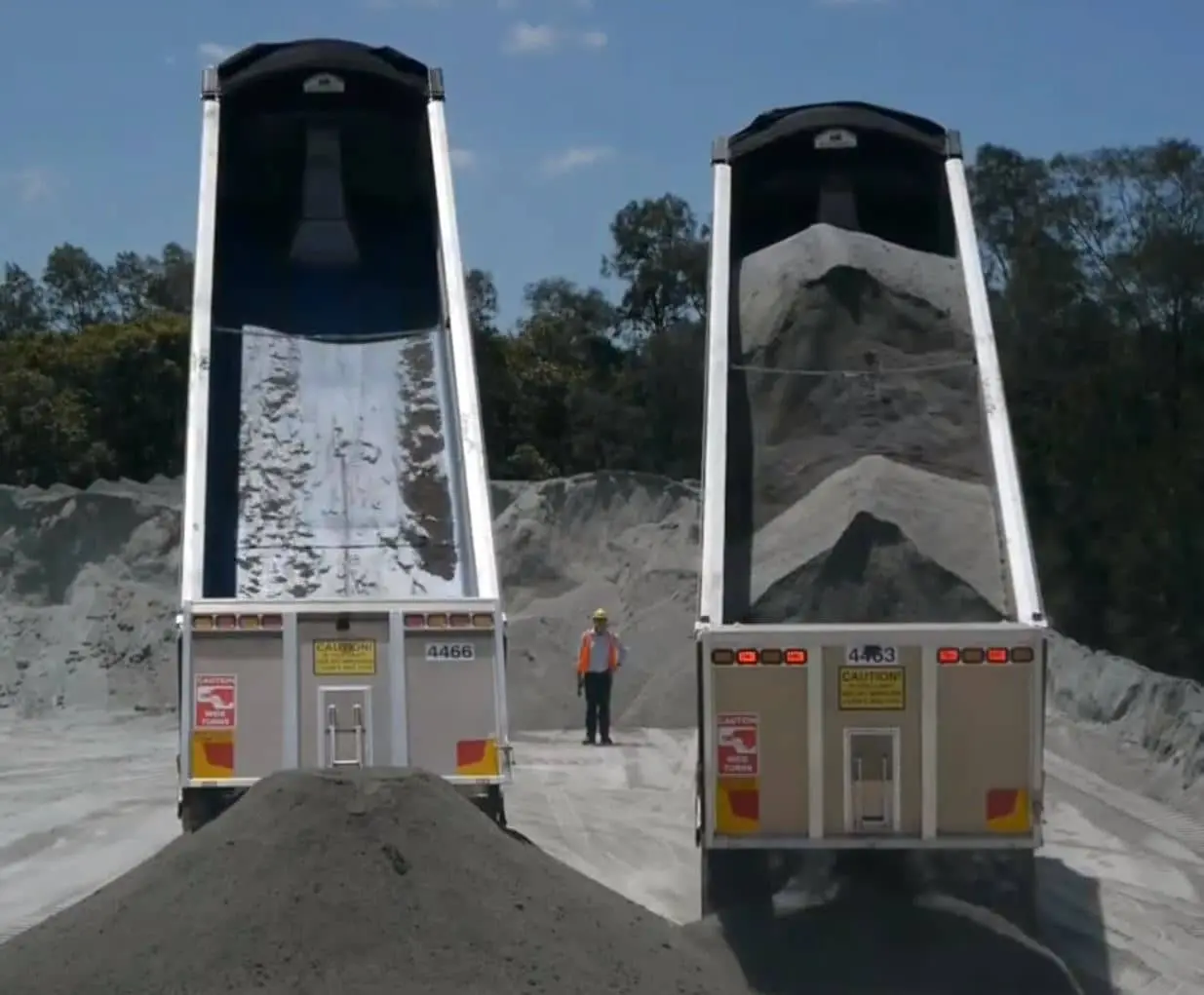At a glance
- High tipping angles raise the centre of gravity, increasing the risk of rollover.
- Sticky, cohesive loads cling to standard trays, forcing unsafe tilt. OKUSLIDE® liners reduce friction for safer discharge.
- Poor tray condition accelerates wear and material hang-up. OKUSLIDE® liners extend tray life and maintain flow.
- Real-time sensors and operator training complete the safety framework, especially when combined with OKUSLIDE’s proven liner performance.
Rollover incidents continue to pose a significant risk in tipping operations, often resulting in equipment damage and serious threats to operator safety. While most fleets focus on training, load limits, and vehicle speed, a key risk factor is often underestimated: the tipping angle.
Tipping angle is a direct determinant of vehicle stability. The higher a tray must rise to discharge material, the more unstable the vehicle becomes, especially on sloped or uneven ground. In many cases, the primary cause isn’t the load weight or terrain; it’s poor material flow caused by rusted trays, high-friction surfaces, or cohesive loads that cling to the body and resist release.
This blog explores the role of the tipping angle in contributing to rollover incidents and how operators can mitigate it through the strategic selection of liners, proper tray maintenance, and effective operator training.
The Role of Tipping Angle in Rollover Risk
The tipping angle directly affects vehicle stability during unloading, and this angle should be as low as possible to reduce strain on the vehicle and minimise rollover risk.
In real-world operations, several factors often compel operators to exceed a safe tipping angle. Common causes for elevated tipping angles include:
- Sticky, cohesive, or wet loads, such as clay, iron ore fines, or damp overburden, that tend to adhere to high-friction tray surfaces, delaying flow and causing hang-ups
- Material hang-up creates uneven weight distribution during discharge, increasing lateral instability
- Sloped or uneven terrain further destabilises the vehicle by shifting the centre of gravity during tipping
The higher the tray must lift, the more the vehicle’s centre of gravity rises. On uneven ground, this elevation increases lateral load transfer, which can rapidly compromise stability and lead to a rollover.
Read More: Common Challenges in Bulk Material Handling and How to Overcome Them
How to Reduce Rollover Risk With Better Tipping Angle Control
Several factors related to tipping increase the likelihood of a rollover during material discharge. These risks, however, can be reduced through a few targeted measures.
Improve Load Release with Low-Friction Liners
Excessive tipping angles often result from poor material release, caused by high-friction tray surfaces. When materials don’t slide freely, especially sticky, cohesive, or moisture-rich loads, operators are forced to raise the tray to unsafe angles. This increases the centre of gravity and introduces lateral forces, which can increase the risk of a rollover.
Traditional steel and aluminium trays often trap these types of materials, requiring steep tilt angles for discharge. Reducing surface friction is one of the most effective ways to lower tipping angles and improve vehicle stability.
That’s where OKUSLIDE® liners provide a critical safety advantage. Manufactured from a proprietary UHMWPE plastic, products like OKUSLIDE® Premium Blue incorporate ultra-low-friction additives that significantly outperform traditional materials in release performance. OKUSLIDE® is up to 60% more slippery than aluminium and 70% more slippery than steel when tested with similar loads and tray angles.
This reduced friction enables faster, cleaner discharge, often at significantly lower tipping angles, helping operators maintain control and reduce the risk of rollover, even with challenging loads. Depending on the load type, operators may experience a reduction in the tipping angle of up to 30 ° with OKUSLIDE® liners.
Read More: Exploring Safety Differences: OKUSLIDE® Versus Traditional Liners
Optimise Tray Design and Maintenance
Tray condition plays a major role in how material flows during discharge. Rust, dents, surface irregularities, or leftover buildup can all increase surface resistance, disrupting flow and forcing operators to tip at unsafe angles. To reduce rollover risk, trays must remain smooth, clean, and structurally sound.
Routine repair and maintenance are essential when handling bulk materials on a daily basis. Frequent tray repairs, however, increase costs and cause operational downtime.
In such cases, using a plastic body liner with impact resistance can be highly beneficial. OKUSLIDE® liners are engineered to improve tray performance even in harsh conditions. Their superior impact and abrasion resistance make them ideal for demanding, high-frequency applications in mining, construction, and agriculture.
Unlike rubber liners, which degrade quickly under repeated impact or sharp material contact, OKUSLIDE® combines flexibility with durability. OKUSLIDE® lasts twice as long as steel and five times as long as aluminium in abrasive conditions. Its high elastic limit allows it to flex under heavy, angular loads without cracking or permanent deformation.
OKUSLIDE® is available in 6 mm to 40 mm sheets for high-impact environments, and in 6 mm or 12 mm coils for longer or curved tray configurations, allowing operators to select the right format for their specific application.
Read More: What Makes OKUSLIDE® the Industry Leader in Truck Body Liners
Use Load Monitoring and Tipping Angle Sensors
Real-time tipping angle sensors have become essential tools for reducing the risk of rollover in tipping operations. These systems monitor the tray angle during the unloading process and alert operators when the vehicle reaches an unsafe tilt angle, especially useful when tipping on sloped or unstable ground.
With access to this live data, operators can make informed, safer decisions and avoid over-tipping. Although the use of load monitoring and tipping angle sensors incurs an additional cost, it can be worthwhile in the long run, as it protects both the operator’s safety and the vehicle.
However, proper training is required to use such sensors and monitoring devices correctly.
Train Operators on Terrain Awareness
Even with durable liners and modern sensors in place, rollover incidents can still occur due to operator error. This is especially true on unstable or uneven terrain. It is essential that operators understand how ground conditions influence vehicle stability and tipping dynamics.
Operators should be trained to assess ground stability before lifting the tray, identify level surfaces, adjust for slope or moisture, and report surface irregularities that may impact tipping safety. Training should also reinforce how varying ground conditions, including slope, compaction, and load placement, influence tipping stability.
When supported by consistent training and reliable equipment, operators develop safer unloading habits and stronger decision-making skills under variable ground conditions, thereby reducing the likelihood of preventable rollovers across the fleet.
Reducing the tipping angle is essential for creating a safer, controlled, and efficient haulage system. Every extra degree of tilt adds vehicle strain and rollover risk. By maintaining that angle through smarter liner technology, proactive maintenance, operator training, and real-time monitoring, fleets gain more than safety; they gain consistency and confidence.
For decision-makers, the tipping angle is a measurable risk that can be mitigated with a few adjustments in equipment and daily operations.
If your current setup forces operators to overtip, clear hang-ups manually, or deal with unpredictable discharge, it’s time to reassess your setup. Contact our team to learn how OKUSLIDE® can help reduce rollover risk and optimise tipping performance across your fleet.



